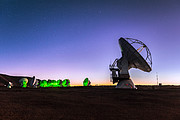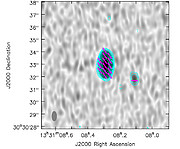Mededeling
ALMA Explores the Magnetic Universe
ALMA’s first full-polarisation observations demonstrate its capacity for doing polarimetry
19 juli 2016
Recent observations have confirmed that ALMA’s excellent sensitivity and calibration accuracy make it a top-class instrument for performing polarimetric measurements at millimetre wavelengths.
Even though ALMA (the Atacama Large Millimeter/submillimeter Array) has been operating since 2011, observations are continuing to verify key aspects of its performance. ALMA was designed to perform sensitive polarimetry — measuring the polarisation of radio waves to reveal the properties of magnetic fields — and astronomers have recently reported the first full-polarisation observations with ALMA, confirming that it is excellently suited to this task.
To do this, astronomers observed the bright source 3C 286. A quasar lying some 7.3 billion light-years from us, 3C 286 is a very powerful source of radio waves and has been observed by many other telescopes. The radio emission from this object is known to be highly polarised, making it an ideal candidate to test ALMA’s capabilities in this area. The ALMA observations reveal details not seen before and clearly show that the magnetic field is stronger and more ordered towards the inner region of the jet that emerges from the quasar. This helps researchers to understand the magnetic field structure in the very heart of the quasar, furnishing vital clues about the physical processes that give rise to the radio emission.
“This observation has certainly verified the high capability of the polarimetry observation with ALMA,” said Hiroshi Nagai at the National Astronomical Observatory of Japan and the leader of the verification team. “This is an important milestone for the ALMA project.”
Magnetic fields are important in many cosmic situations but they are very difficult to measure. Polarimetry is one of the few methods able to reveal details of magnetic fields. However, the polarised component of the radio waves — the part measured in polarimetry — may only be a few percent of the total radio flux from an object, and therefore high sensitivity is essential to carry out precise polarimetry. ALMA has the sensitivity needed to make these crucial polarimetric observations, as this latest study has confirmed.
More Information
These results were published in the Astrophysical Journal on 20 June 2016 in a paper entitled “ALMA Science Verification Data: Millimeter Continuum Polarimetry of the Bright Radio Quasar 3C 286” by H. Nagai et al.
The team is composed of: H. Nagai (National Astronomical Observatory of Japan, Tokyo, Japan), K. Nakanishi (National Astronomical Observatory of Japan, Tokyo, Japan; The Graduate University for Advanced Studies, Tokyo, Japan; Joint ALMA Observatory, Santiago, Chile), R. Paladino (INAF-Osservatorio di Radioastronomia, Bologna, Italy), C.L.H. Hull (Harvard-Smithsonian Center for Astrophysics, Cambridge, Massachusetts, USA; Jansky Fellow of the National Radio Astronomy Observatory), P. Cortes (Joint ALMA Observatory, Santiago, Chile; National Radio Astronomy Observatory, Charlottesville, Virginia, USA), G. Moellenbrock (National Radio Astronomy Observatory, Socorro, New Mexico, USA), E. Fomalont (Joint ALMA Observatory, Santiago, Chile; National Radio Astronomy Observatory, Charlottesville, Virginia, USA), K. Asada (The Academia Sinica Institute of Astronomy and Astrophysics, Taipei, Taiwan) and K. Hada (National Astronomical Observatory of Japan, Tokyo, Japan).
The Atacama Large Millimeter/submillimeter Array (ALMA), an international astronomy facility, is a partnership of ESO, the U.S. National Science Foundation (NSF) and the National Institutes of Natural Sciences (NINS) of Japan in cooperation with the Republic of Chile. ALMA is funded by ESO on behalf of its Member States, by NSF in cooperation with the National Research Council of Canada (NRC) and the National Science Council of Taiwan (NSC) and by NINS in cooperation with the Academia Sinica (AS) in Taiwan and the Korea Astronomy and Space Science Institute (KASI).
ALMA construction and operations are led by ESO on behalf of its Member States; by the National Radio Astronomy Observatory (NRAO), managed by Associated Universities, Inc. (AUI), on behalf of North America; and by the National Astronomical Observatory of Japan (NAOJ) on behalf of East Asia. The Joint ALMA Observatory (JAO) provides the unified leadership and management of the construction, commissioning and operation of ALMA.
Contact
Hiroshi Nagai
National Astronomical Observatory of Japan
Osawa 2-21-1
Mitaka, Tokyo, Japan
Email: hiroshi.nagai@nao.ac.jp
Peter Grimley
ESO Assistant Public Information Officer
Garching bei München, Germany
Email: pgrimley@partner.eso.org
Over de Mededeling
| Id: | ann16050 |
Our use of Cookies
We use cookies that are essential for accessing our websites and using our services. We also use cookies to analyse, measure and improve our websites’ performance, to enable content sharing via social media and to display media content hosted on third-party platforms.
ESO Cookies Policy
The European Organisation for Astronomical Research in the Southern Hemisphere (ESO) is the pre-eminent intergovernmental science and technology organisation in astronomy. It carries out an ambitious programme focused on the design, construction and operation of powerful ground-based observing facilities for astronomy.
This Cookies Policy is intended to provide clarity by outlining the cookies used on the ESO public websites, their functions, the options you have for controlling them, and the ways you can contact us for additional details.
What are cookies?
Cookies are small pieces of data stored on your device by websites you visit. They serve various purposes, such as remembering login credentials and preferences and enhance your browsing experience.
Categories of cookies we use
Essential cookies (always active): These cookies are strictly necessary for the proper functioning of our website. Without these cookies, the website cannot operate correctly, and certain services, such as logging in or accessing secure areas, may not be available; because they are essential for the website’s operation, they cannot be disabled.
Functional Cookies: These cookies enhance your browsing experience by enabling additional features and personalization, such as remembering your preferences and settings. While not strictly necessary for the website to function, they improve usability and convenience; these cookies are only placed if you provide your consent.
Analytics cookies: These cookies collect information about how visitors interact with our website, such as which pages are visited most often and how users navigate the site. This data helps us improve website performance, optimize content, and enhance the user experience; these cookies are only placed if you provide your consent. We use the following analytics cookies.
Matomo Cookies:
This website uses Matomo (formerly Piwik), an open source software which enables the statistical analysis of website visits. Matomo uses cookies (text files) which are saved on your computer and which allow us to analyze how you use our website. The website user information generated by the cookies will only be saved on the servers of our IT Department. We use this information to analyze www.eso.org visits and to prepare reports on website activities. These data will not be disclosed to third parties.
On behalf of ESO, Matomo will use this information for the purpose of evaluating your use of the website, compiling reports on website activity and providing other services relating to website activity and internet usage.
Matomo cookies settings:
Additional Third-party cookies on ESO websites: some of our pages display content from external providers, e.g. YouTube.
Such third-party services are outside of ESO control and may, at any time, change their terms of service, use of cookies, etc.
YouTube: Some videos on the ESO website are embedded from ESO’s official YouTube channel. We have enabled YouTube’s privacy-enhanced mode, meaning that no cookies are set unless the user actively clicks on the video to play it. Additionally, in this mode, YouTube does not store any personally identifiable cookie data for embedded video playbacks. For more details, please refer to YouTube’s embedding videos information page.
Cookies can also be classified based on the following elements.
Regarding the domain, there are:
- First-party cookies, set by the website you are currently visiting. They are stored by the same domain that you are browsing and are used to enhance your experience on that site;
- Third-party cookies, set by a domain other than the one you are currently visiting.
As for their duration, cookies can be:
- Browser-session cookies, which are deleted when the user closes the browser;
- Stored cookies, which stay on the user's device for a predetermined period of time.
How to manage cookies
Cookie settings: You can modify your cookie choices for the ESO webpages at any time by clicking on the link Cookie settings at the bottom of any page.
In your browser: If you wish to delete cookies or instruct your browser to delete or block cookies by default, please visit the help pages of your browser:
Please be aware that if you delete or decline cookies, certain functionalities of our website may be not be available and your browsing experience may be affected.
You can set most browsers to prevent any cookies being placed on your device, but you may then have to manually adjust some preferences every time you visit a site/page. And some services and functionalities may not work properly at all (e.g. profile logging-in, shop check out).
Updates to the ESO Cookies Policy
The ESO Cookies Policy may be subject to future updates, which will be made available on this page.
Additional information
For any queries related to cookies, please contact: pdprATesoDOTorg.
As ESO public webpages are managed by our Department of Communication, your questions will be dealt with the support of the said Department.


